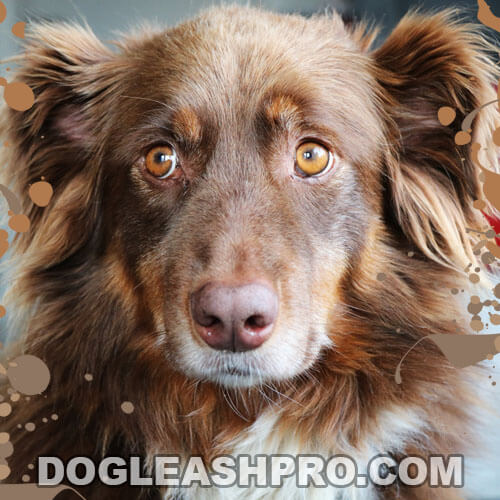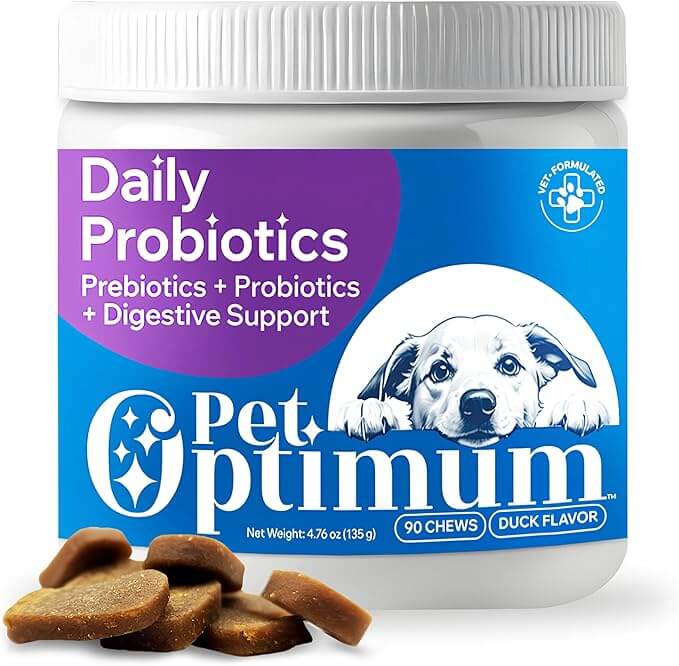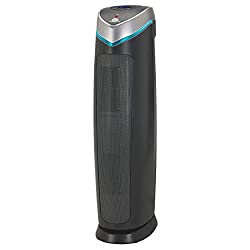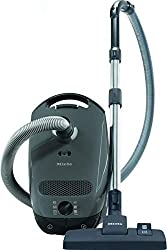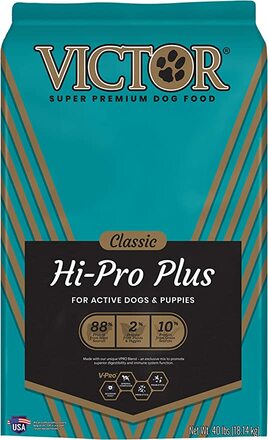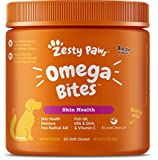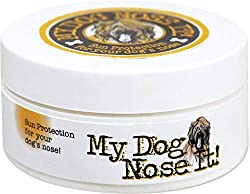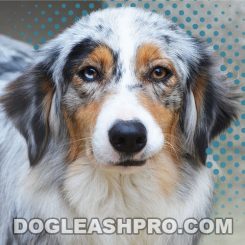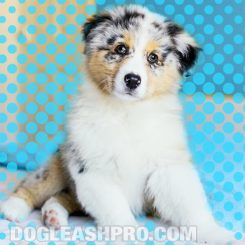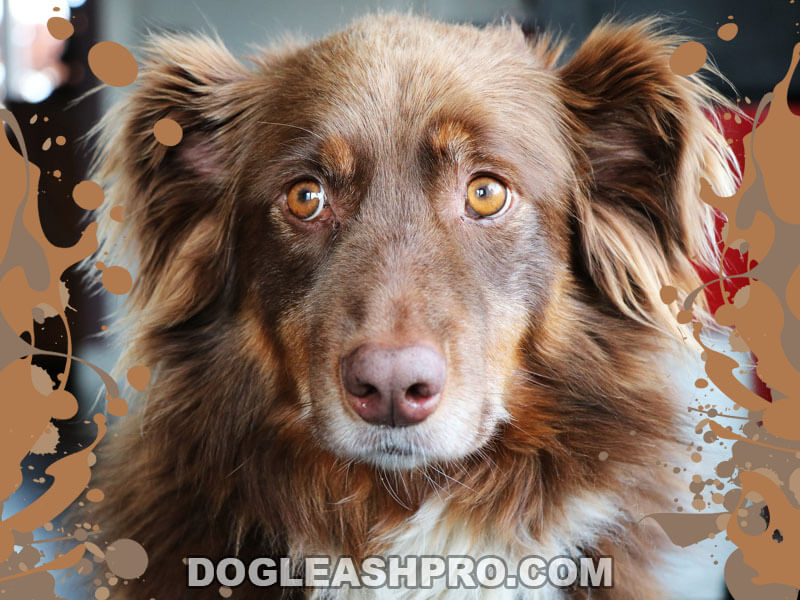
Are Australian Shepherds Hypoallergenic? No, Australian Shepherds are not hypoallergenic because their double coat blows out seasonally during the fall and spring months. Their double coat naturally sheds from moderate to high levels all year round. Aussies also require regular grooming to control their shedding. Lastly, due to their medium size, they have medium to high levels of dander.
The Australian Shepherd, or Aussie for short, has become one of the more popular dog breeds in recent times due to its intelligence, great energy, and hardworking quality. But, can they be a good fit in a household with allergy sufferers?
In this comprehensive article, we will discuss in detail how the Australian Shepherd fares in causing allergic reactions, and do Australian Shepherds shed as much hair compared to other dog breeds. We’ll also go over what Aussie owners can do to reduce dog allergy around your home.
Table of Contents
Are Aussies Hypoallergenic? Why not?
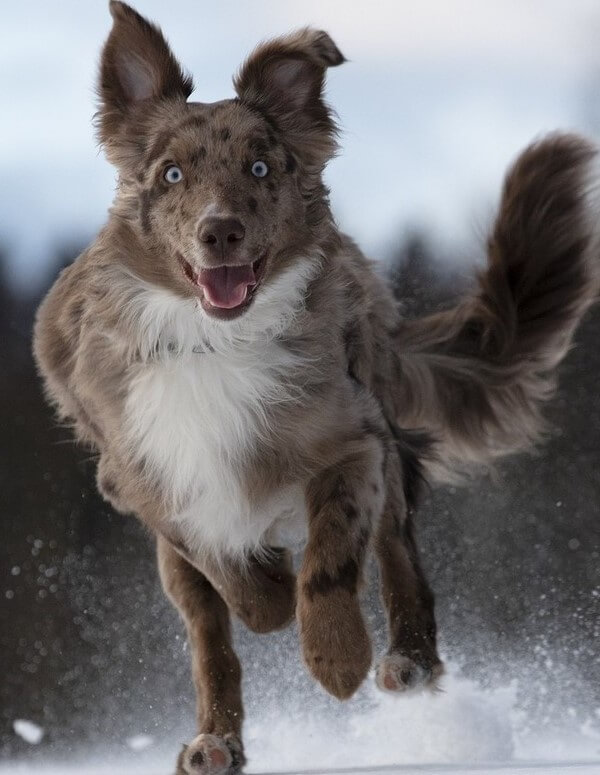
Aussies are not hypoallergenic because their dander and dried saliva can cause breathing difficulties or allergic skin reactions in some people. Asthma sufferers may have to reconsider having Aussies as canine companions since they are moderate to high shedders that can spread allergens around the house.
Australian Shepherd history
The Australian Shepherd came into being after years of crossbreeding. The Aussie is a result of crossbreeding several herding dog breeds like the Pyrenean Shepherd, the Carea Leones, and the Basque Shepherd Dog.
Basque immigrants first brought these dogs to the Australian Outback in the 1800s to help in cattle herding. It was during this time that they crossed these dogs with the Collie and the Border Collie.
In the succeeding years, these dogs were further refined and developed in California to what we now know as the Australian Shepherd. Some Aussies today are still being used to herd livestock.
The Australian Shepherds have also became popular in rodeo circuits across the western United States. The Australian Shepherd was finally recognized by the American Kennel Club (AKC) in the 1990s and became one of the more popular breeds.
What does Hypoallergenic mean?
Hypoallergenic means that a dog’s fur is less likely to cause allergic reactions in people. All types of dogs, whether their coat will shed or not, will in some way still cause allergies.
What are dog allergies? How do you know if you have dog allergies?
Dog allergies refer to the reaction some people have from the dander, dried saliva, and urine that adheres to a dog’s hair, particularly the loose ones that scatter through the air.
These particles are harmless but some people’s bodies interpret these as foreign objects that the immune system needs to eject from the body by producing histamines.
Histamines are nitrogenous compounds that our human body’s immune system creates in order to protect from invading substances.
This compound dilate the tiny blood vessels in our noses and causes runny nose, watery eyes, sneezing, swelling, and itching.
What makes a dog hypoallergenic?
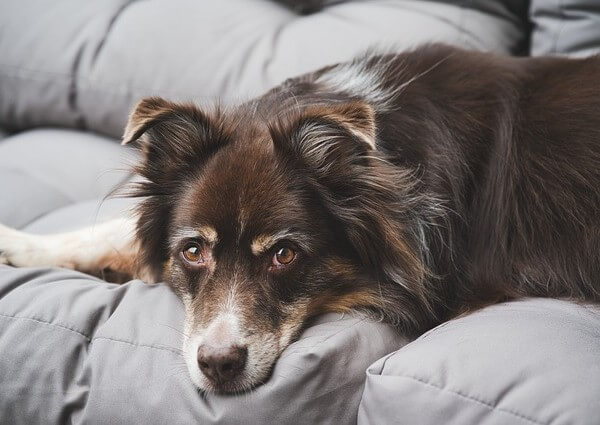
A dog is considered hypoallergenic when he sheds less fur (and as a result, less dander and saliva) making people with allergies less likely to inhale the dander and dried saliva that sticks to a dog’s loose fur.
Australian Shepherd drooling and dander levels
People typically have an allergic reaction to the saliva and microscopic dried flecks of skin or dander a dog creates.
Australian Shepherds, because of their medium size, will produce moderate amounts of dander when they shed and these can stick to furniture and fabrics.
Luckily, they do not drool as much as other dog breeds (such as the Mastiff or Saint Bernard), but the dried saliva in their coat can still cause allergic reactions.
Different types of Canine Proteins
Scientists have identified 7 proteins produced by dogs or Canis familiaris allergens that can cause allergies in people. .
Australian Shepherds produce 6 of these proteins which are designated serially as the following:
- Can f 1.
- Can f 2.
- Can f 3.
- Can f 4.
- Can f 5.
- Can f 6.
Can f 1 is produced in the tongue and is the most common protein found in most of our dog’s skins.
Can f 2, 4, and 6 are produced in the tongue as well.
Can f 3 is found in the urine.
Can f 5 is produced by the prostate glands, so only intact male Australian Shepherds can produce it.
People will have different allergic reactions to these canine proteins and not everyone can be allergic to every type.
Size of the Aussie can affect dog allergies
The size of an Australian Shepherd does have an effect on the amount of loose furs he sheds. Larger dogs have more skin coverage and thus have more fur. A Toy Australian Shepherd would therefore produce fewer allergens than a standard or mini Aussie.
Is an Australian Shepherd Hypoallergenic to you and your family?
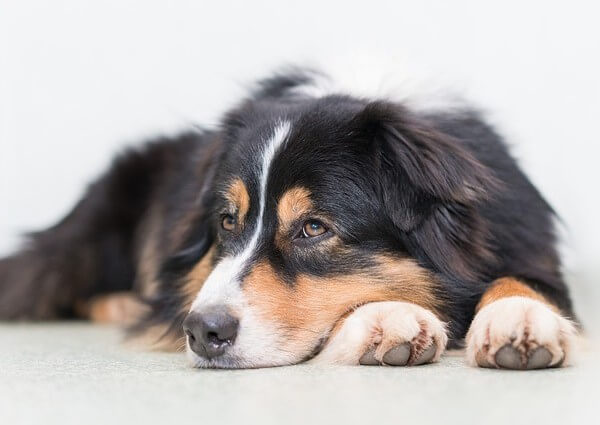
There are three (3) possible reasons why you and your family can be allergic to Australian Shepherd.
First, Australian Shepherds are moderate to heavy shedders all-year-round. Their double coat, both the top coat and the undercoat, sheds continually throughout the year and much more heavily during the fall and spring months when their body is preparing for the upcoming warm or cold months.
Second, Aussies produce dander that is composed of dead skin cells that can trigger an allergic reaction when inhaled.
Third, the Australian Shepherd has medium-length fur which small particles of dander and dried saliva can easily adhere to. Their loose fur can be suspended in the air and can easily attach to fabrics and furniture.
So, are Aussie dogs Hypoallergenic?
As we can see, Aussie dogs are not hypoallergenic because their coat sheds all year round. Shedding brings with it allergens that could spread around your surroundings.
Shedding is part of their normal physical function not just to get rid of old furs but also to regulate their body temperature.
Are Australian Shepherds bad for allergies?
Unfortunately, Australian Shepherds are not good for those who suffer from severe allergies. Those with mild reactions to dog fur may be able to have an Aussie as a pet provided that they take certain measures, like regular brushing and grooming, as well as, daily cleaning of their home in order to minimize any severe episodes of allergy.
15 Tips to reduce dog allergy around your home
1. Taking the right supplements for healthy skin and coat
Vitamins A, B, C, and E, as well as, mineral supplements like magnesium and healthy fats such as omega-3 can do great wonders to their overall health.
In addition to these essential nutrients, probiotics can also make a significant difference in managing skin allergies and promoting a healthier coat.
PetOptimum Probiotics for Dogs are designed to support your dog’s gut health, which in turn strengthens their immune system and reduces the likelihood of skin inflammation and allergies. This vet-formulated soft chews don’t just help with digestion—they also contribute to softer skin and a shinier coat, giving your dog relief from itchy, irritated skin.
Because your dog deserves to feel comfortable and loved, inside and out.
2. Invest in an air purifier with HEPA filter
Air purifier with high efficiency particulate air filter, or HEPA filter for short, can trap dander and other small particles in the air including dust, dust mites, pollen, and mold when it passes through the fine mesh.
Some air purifier with HEPA filter also features UV light filters which helps to remove germs and odors.
3. Vacuum frequently with a powerful HEPA filter vacuum cleaner
A powerful vacuum can also remove mostly anything in its path including ticks and fleas that could further contribute to your Aussie’s skin and shedding problems.
4. Brush your Aussie daily
Regular brushing will reduce the amount of loose furs hanging around your home and will also make their coat cleaner and healthier making him less likely to shed heavily.
5. Use the right tools
Due to their thick double coat, using different tools, like a slicker brush, pin brush, or a de-shedding tool to deal with the different requirements of the topcoat and undercoat is necessary.
6. Buy plenty of lint rollers
Using lint rollers is a quick way to remove furs from your clothing, fabrics, and furniture.
7. Bathe your Aussie, but not too often!
Bathing can also loosen and remove loose fur, but doing so frequently can dry out their skin which could lead to more shedding. They should be bathed only when necessary or every 1 to 2 months.
8. Use the right dog shampoo
When bathing your Aussie, be sure to only use dog shampoos that contain natural ingredients, like aloe vera and oatmeal which will keep their skin and coat in good condition and healthy.
Additionally, the doggy shampoo should be easy to rinse and specially made to reduce shedding.
A good dog shampoo is reduce shedding should be one that is enriched with omega 3 and 6 fatty acids to promote heathy coat and skin.
9. Wash your clothes, beddings, and covers regularly
The amount of allergens getting suspended in the air will be reduced greatly if loose fur is washed off from fabrics, your clothing, beddings, sheets, and covers.
10. Be selective with the type of flooring for your home
Be mindful when choosing the right flooring for your home. Flooring like heavy carpets or rugs are magnets for dander and loose fur.
11. Train your Australian Shepherd to stay away from your bed and furniture
Giving your Aussie their own chew proof dog beds will minimize their habit of jumping onto your bed or furniture.
12. Nutritious and high-quality dog food is a must
Having a well-balanced diet is key to ensuring that their health is in optimum state which can be determined by the glow of their skin and coat. Continue reading to find out the best food for your Aussie pup.
13. Exercise, exercise, exercise!
Regular exercise prevents canine obesity and other health problems (including shedding) and will keep their body in tiptop shape.
14. Bring your Aussie for his regular vet check-up
Regular visits to the vet can pinpoint why your Aussie may be shedding excessively as well as other diseases that could otherwise affect your Aussie’s coat health.
15. Visit your allergist
Allergens can be hard to avoid, so having a medical prescription can help alleviate some of your allergic attacks.
Australian Shepherd grooming requirements
Having the right tools to maintain your Aussie dog’s coat will help reduce the amount of loose furs around your home.
Use an appropriate dog shampoo, specifically with natural ingredients and those formulated for thick coats, that can deeply wash and clean their coat.
Avoid using human shampoos on your K9 friends because they may contain detergents or other harmful ingredients that can irritate your pup’s skin.
For removing knots and tangles, use a slicker brush which have angled pins that can penetrate the undercoat. It has the added benefit of stimulating their skin and distributing the natural oils throughout their coat.
A pin and bristle combination brush is another useful tool which can be used for light brushing or a touch up. Bristle brush is ideal for removing dirt and debris from their top coat especially after some physical activity, while a pin brush with rounded ends can untangle minor knots and also circulate air around their coat.
A steel comb is useful in grooming their mane and feathered areas around the neck. It also helps in teasing out mats and tangles when used in conjunction with a slicker brush.
Finally, a de-shedding tool is perfect to use during the heavier shedding season when they are blowing their coat. It can remove more loose hairs in one sweep compared to a slicker brush.
Australian Shepherd coat care
An Australian Shepherd’s coat should be brushed 2 to 3 times weekly for at least 5 to 10 minutes depending on the condition of the coat.
You can start by using a slicker brush to remove any tangles with the help of a steel comb. Then finish it off with a pin or bristle brush to further distribute the natural oils. A bristle brush can also be used to remove any dirt after some physical activity.
During the spring or fall seasons when they blow out their fur, you can use a de-shedding tool instead of a slicker brush to better remove the dead loose furs.
However, be aware not to use it for more than two times weekly for this can remove even the healthy and undamaged furs. When brushing, you’ll want to be careful not to apply too much pressure because this can hurt your dog’s skin.
When it comes to bathing, it should preferably be done only when their coat becomes too dirty or start to become smelly. Washing their coat once a month or even every two (2) months is recommended. Frequent washing can rob their coat of their natural oils and even cause skin dryness and more shedding.
How do you know if dogs have allergies?
To know if your Australian Shepherd has allergies or something else, the common signs are non-stop itching, corn chip smell from his feet as a result of bacterial infections, and, for some, coughing.
Plus, if you notice that your Australian Shepherd is constantly plagued with ear infections, he may be allergic to something.
Australian Shepherd allergies
Unfortunately, Australian Shepherds are prone to allergies, with most of them starting to develop skin allergies at about 1 to 2 years of age.
What are Australian Shepherds allergic to?
Australian Shepherds can be allergic to certain food like chicken or soy products.
Environmental factors like pollen and molds can also trigger allergic reactions in dogs.
Not to forget that heavy flea infestations can also cause allergy dermatitis because of flea saliva.
You may be interested in: Engorged Tick Fell Off Dog: Here’s What To Do!
Australian Shepherd food allergies
To find out what foods are Australian Shepherds allergic to, it requires a trial-and-error process. For most dogs with food allergies, the culprit is poultry like turkey and chicken.
To learn what your Australian Shepherd sensitive stomach is allergic to, we suggest that you feed him chicken and observe if there are reactions like itching and skin redness.
If none, then you can stick to that protein source. However, if he reacts to it, then, try another protein source like pork, beef, or lamb and observe again.
In short, solving food allergies may take a while and require patience on your part to discover which food protein will not result in skin allergies.
Good food for Australian Shepherd
The Australian Shepherd is an active dog breed that needs a significant amount of protein and fats for healthy muscles and skin, and for a glossy coat.
Below, we have two food products your Australian Shepherd can try because these two food options have a good balance of nutrients which is perfect for energetic dog breeds.
The first dog food product we highly recommend is the Victor Super Premium Dog Food – Hi-Pro Plus Dry Dog Food because it is gluten-free, packed full of protein, and contains healthy ingredients for healthy skin and coat.
Gluten-free means that the dog food only contains a minimum amount of grains that may trigger allergic reactions.
The Victor Super Premium dog food is highly-packed with protein. 80% of the food comes from meat sources like beef and pork. It is made with other ingredients that support healthy digestion, improve skin and coat conditions, and strengthen the immune system of active dogs like an Australian Shepherd.
Best dog food for Australian Shepherd with allergies
Another dog food brand we highly recommend if your Aussie has sensitive stomach is the Hill’s Science Diet Adult Sensitive Stomach Skin Dry Dog Food.
That’s because this dog food comes with prebiotic fiber which is an ingredient for a healthy gut. Digestive or gut health is important because it affects overall nutrient absorption.
Plus, this dog food contains vitamin E and omega fatty acids to promote healthy skin and coat.
Supplements for Australian Shepherds
Does your Australian Shepherd need supplements?
As mentioned a while ago, this dog breed tends to suffer from skin allergies. Though dog food may contain a good amount of fatty omega acid for skin and coat, it may not be enough to combat skin inflammations.
Therefore, we highly suggest that you pick a supplement that is proven to address the problem of skin sensitivity issues of Australian Shepherds.
We highly recommend the Zesty Paws Omega Bites because it is made with Alaskan Pollock which is a great source for fatty omega acids that improve the skin and coat conditions of dogs with allergies.
Plus, dogs love the delicious taste of each soft chew, making it convenient to add this supplement to your dog’s daily diet.
Essential ingredients to combat Australian Shepherd food allergies
To fight skin allergies, you need to be very careful about what to feed your Australian Shepherd. Essential vitamins and minerals are crucial and they play a huge role in reducing skin inflammation and itchiness.
| Health Condition | Dietary requirements and Adjustments |
| Dermatitis and chronic itching | Increased vitamin E intake and biotin. |
| Crustiness and dandruff | Omega fatty-acids. |
| Scaling and dull coat | Vitamin E and A. |
| Change in coat color | Omega fatty acids and oatmeal bath. |
| Gastrointestinal signs | Vitamin B12, fiber, and prebiotic supplement. |
Australian Shepherd itching and losing hair
All Australian Shepherds have long and thick hair, so in case you see a hairless Australian Shepherd, it is highly probable that the dog has skin problems.
Skin allergies, be it caused by food or triggered by the environment like pollens, constant scratching and licking may later lead to patches of hair loss.
RECOMMENDED: Dog Losing Hair Around Eyes? (9 Top Reasons + What To Do)
The other reason why you see a hairless Australian Shepherd is because of mange infestation.
Australian Shepherd skin problems
Australian Shepherd itchy skin may be caused by different factors.
Did you just change the diet of your dog? If yes, the reason for itchy skin is food allergies.
Or, perhaps a change in weather is the one causing Australian Shepherd dry skin which is referred to as seasonal allergies.
Factors like pollens, mildew, or grass may lead to intense scratching and dry and flaky skin.
Australian Shepherd coat types and colors
Australian Shepherds are double-coated with medium-length hair that can either be straight or wavy. The coat may come in the following colors and combinations:
- Solid black.
- Solid red.
- Blue merle.
- Red merle.
- Bicolor.
- Tricolor.
RELATED: Blue Merle Australian Shepherd (Complete Guide)
Is the Blue Merle Australian Shepherd hypoallergenic?
No, blue merle Australian Shepherd is not hypoallergenic. Regardless of coat color, be it a Blue Merle or not, all Australian Shepherds are double-coated, hence, they are not hypoallergenic.
Location of the skin allergies in Australian Shepherds
The common body parts that are itchy in dogs with skin allergies are the ears, tails, underarms, and paws. This is why Australian Shepherd paws may appear reddish or inflamed if he has skin allergies. It is common for Australian Shepherds to bite their paws as a way to relieve itchiness.
ALSO READ: Home Remedies For Dog Scooting: 10 Easy Ways That Work Fast!
Causes of Australian Shepherd skin allergies
We’ve listed below the causes of skin allergies in Australian Shepherds that lead to Australian Shepherd skin scabs and Australian Shepherd hot spots.
- Contact dermatitis can be due to environmental factors including pollens or household products like fabric softeners used in washing doggie blankets.
- Food allergies from meat protein and dairy products.
- Flea allergy from flea bites.
- Pyoderma is a type of bacterial infection that causes Australian Shepherd skin scabs.
- Yeast dermatitis is caused by a fungal infection and commonly affects the ears.
READ NEXT: Dried Dead Tick On Dog (How To Remove & What To Do)
Why is my Aussie so itchy?
Also referred to as pruritus, if your Aussie is itchy, then it may be coming from any of the causes that we’ve identified above.
If you fail to address this problem, it may lead to excessive licking, biting, and hair loss.
In some cases, the skin may even get infected and your furry friends may have to be prescribed antibiotics to stop the infections.
CHECK OUT: Why Is My Dog Licking The Floor?
Treatment options to fight skin problems in Aussies
Fortunately, there are treatment options and remedies that you can do to fight skin infections in dogs. Some of these do not require veterinarian intervention while some have to be under their guidance and observations.
3 Short-term treatments:
- Give your Aussie an oatmeal bath to relieve itchiness.
- Wash your dog’s paws and wipe his coat with doggie wipes to get rid of allergens that he came in contact with outside.
- Application of topical medicines as prescribed by a veterinarian.
3 Long-term treatments:
- Change to a different source of animal protein. For instance, from turkey to lamb.
- Use medicated dog shampoos that have antiseptic properties.
- The use of medications like antihistamines or steroids as prescribed by your dog’s vet.
Are Mini Australian Shepherds Hypoallergenic?
If you’re wondering, “Are mini Aussies hypoallergenic?” the answer is no, mini Australian Shepherds are not hypoallergenic.
A mini Australian Shepherd hypoallergenic is simply impossible because he has a double layer of coat that shed all year long. The dander and the protein from his saliva are also other factors that make it impossible for a mini Aussie hypoallergenic.
Mini Aussie shedding
Same as the standard-sized Aussies, the mini Aussies also shed moderately to high all year round, more so during the changing of the season.
Mini Aussie grooming requirements
Grooming mini Australian Shepherd is one of the best ways to reduce the level of shedding.
Mini Australian Shepherd grooming should include frequent brushing using de-shedding tools like FURminator or a slicker brush.
Grooming mini Aussie also involves at least once a month bathing. If your mini Aussie has skin problems, choose medicated dog shampoo and conditioner when grooming miniature Australian Shepherd.
Plus, grooming a mini Aussie includes nail trimming, ear and eye cleaning, and teeth brushing for a well-groomed mini Aussie.
Mini Aussie haircuts
It’s best to go to a certified dog groomer to style a mini Aussie. The most common haircuts are:
- Teddy cut.
- Simba style.
- Rounded cut.
- Minimal cut.
Mini Australian Shepherd allergies
The allergies of a Mini Australian Shepherd is the same as the standard-sized Aussies. The mini Aussies can also be plagued with skin allergies brought about by food, seasons or weather, and flea infestations.
You may also like: Can Dogs Eat Crackers?
Are toy Aussies Hypoallergenic?
How about toy Aussies? Are toy Australian Shepherds Hypoallergenic?
The answer is no, toy Aussies are not hypoallergenic. While they may be smaller in size, they still sport the two layers of coat which sheds moderately to heavy all throughout the year and sheds heavily at least twice a year.
Australian Shepherd Hypoallergenic mix
Are you looking for a hypoallergenic Australian Shepherd mix? These three non shedding Australian Shepherd mixed dogs may be what you’re looking for:
- Australian Shepherd mixes with a Poodle because Poodles are considered hypoallergenic.
- A giant Schnauzer mixed with an Australian Shepherd could be a hypoallergenic dog, provided that the dominant gene is the Giant Schnauzer.
- Mixing an Irish Water Spaniel with an Aussie may significantly reduce the amount of shedding and dander.
DON’T MISS: Do Aussiedoodles Shed?
Are Australian Labradoodles Hypoallergenic?
Yes, an Australian Labradoodle is developed by mixing Labradors, Cocker Spaniels, Poodles, Curly Coated Retrievers, and Irish Water Spaniels to produce dogs that shed minimally.
Best dog breeds for Aussie-loving allergy sufferers
If you’re looking for hypoallergenic dog breeds, we’ve listed some of them for you. Just the same, these hypoallergenic dogs need to be groomed, otherwise, their coats will tangle and may form heavy matting and tangles.
American Hairless Terrier
Available in two sizes, this dog breed is almost hairless except for his eyebrows and whiskers. This dog breed is perfect for allergy sufferers but he requires special care to avoid sunburns. Be sure to apply dog-safe sunscreen if you’re heading out for some fun.
DON’T MISS: Pink Spot On Dog’s Nose (What Does It Mean?)
Irish Water Spaniel
A dog breed with a double layer of coat, the inner coat is soft while the outer coat is water- repellant. This is a hypoallergenic dog breed that sheds very minimally. But he needs to be brushed frequently to prevent mats and tangles from forming.
Poodle
A Poodle does not shed but its coat is very prone to heavy matting. It needs to be brushed 3 to 4 times a week using a slicker brush. If you see some mats starting to form, take your pooch to the groomer as soon as you can.
Portuguese Water Dog
If you love water sports, this dog breed would be your perfect companion. The coat can either be wavy or curly and comes in various shades like brown and white. It is a single-coated coat that sheds very minimally.
Schnauzer
Schnauzers hardly sheds, hence they are good for allergy sufferers. Plus, this breed does not drool a lot. The coat can be trimmed at least once every 2 months to get rid of mats.
Miniature Schnauzer
Same as the standard-sized Schnauzer, this little fellow is also hypoallergenic. Shedding won’t be a problem if you decide to bring home a mini Schnauzer.
Since she does not shed much, you will not many fur around your home but do give her a bath at least once every 6 weeks.
Soft Coated Wheaten Terrier
A people-oriented and kid-friendly dog, the soft coated Wheaten Terrier is another hypoallergenic dog breed we recommend. Though they have tons of hair, they do not shed much. They are single-coated and do not produce as much dander.
Are Sheepdogs Hypoallergenic?
No, sheepdogs including Australian Shepherds are not hypoallergenic.
So, Are Australian Shepherds Hypoallergenic?
If you are hoping to care for an Australian Shepherd dog but worry if he is hypoallergenic or not, well, sorry to disappoint you but this dog breed is a moderate to heavy shedder.
Allergens like dander will attach to his fur which he sheds on a daily basis. If you’re sensitive, you may suffer from sneezing, nasal congestion, and watery eyes to name a few.
Related Questions
Apart from being a very energetic dogs, Australian Shepherds shed a lot all throughout the year.
No because Australian Shepherds are moderate to heavy-shedding dog breeds that sheds year round and sheds heavily during the spring and fall.
Labradoodles are considered to be the best hypoallergenic dog breed.
You may not be sensitive to dog dander and the protein particles that cause allergic reactions. Or maybe it’s because you brush your dog regularly and you use air purifiers at home which all helps in reducing allergic reactions to Australian Shepherds.
Bichon Frise is one of the calmest hypoallergenic dogs. This breed is friendly and very affectionate.
DISCLAIMER: THIS WEBSITE DOES NOT PROVIDE MEDICAL ADVICE
The information, including but not limited to, text, graphics, images and other material contained on this website are for informational purposes only. No material on this site is intended to be a substitute for professional veterinary advice, diagnosis, or treatment. Always seek the advice of your veterinarian or other qualified health care provider with any questions you may have regarding a medical condition.
Resources:
https://australianshepherds.org/programs/usasa-health-genetics-program/
https://www.ashgi.org/home-page/genetics-info/testing-screening-programs

With over five years of specialized experience as an animal writer, my expertise lies in dog nutrition, health, behavior, grooming, and training. I am dedicated to delivering helpful and informative content that caters to the well-being of our furry friends. My primary goal is to empower pet owners with knowledge and ensure our canine companions thrive in health and happiness. In my free time, I love volunteering at local dog rescue centers.
